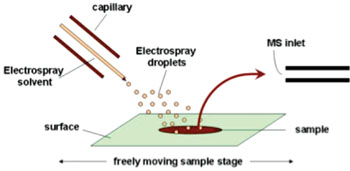Mass Spectroscopy Techniques Detect Cocaine Metabolites in Fingerprints
By LabMedica International staff writers
Posted on 27 May 2015
Two mass spectroscopy (MS) techniques have been adapted for detecting cocaine and its metabolites benzoylecgonine (BZE) and methylecgonine (EME) from latent fingerprints.Posted on 27 May 2015
Latent fingerprints provide a potential route to the secure, high throughput, and noninvasive detection of drugs of abuse. Working with fingerprints stands in contrast to traditional methods of blood, saliva, or urine testing, which are performed on bio-hazardous materials and require trained staff for analysis,

Image: Schematic diagram of the DESI ion source (Photo courtesy of Wikimedia Commons).
Investigators at the University of Surrey (United Kingdom) and colleagues at other institutions in the United Kingdom and the Netherlands evaluated three different MS procedures for their ability to detect cocaine and its metabolites in finger prints.
In their study, gas chromatography-mass spectrometry (GC-MS) was used to test the oral fluid of patients for the presence of cocaine and benzoylecgonine. The corresponding fingerprints were analyzed using Desorption Electrospray Ionization (DESI), Ion Mobility Tandem Mass Spectrometry Matrix Assisted Laser Desorption Ionization (MALDI-IMS-MS/MS), and Secondary Ion Mass Spectrometry (SIMS).
DESI is a combination of electrospray (ESI) and desorption (DI) ionization methods. Ionization takes place by directing an electrically charged mist to the sample surface that is a few millimeters away. The electrospray mist is attracted to the surface by applying a voltage on the sample holder. After ionization, the ions travel through air into the atmospheric pressure interface which is connected to the mass spectrometer. DESI is a technique that allows for ambient ionization of a trace sample at atmospheric pressure, with little sample preparation.
Matrix-assisted laser desorption/ionization (MALDI) is a soft ionization technique used in mass spectrometry, allowing the analysis of biomolecules (biopolymers such as DNA, proteins, peptides, and sugars) and large organic molecules (such as polymers, dendrimers, and other macromolecules), which tend to be fragile and fragment when ionized by more conventional ionization methods. It is similar in character to electrospray ionization (ESI) in that both techniques are relatively soft ways of obtaining ions of large molecules in the gas phase, though MALDI produces far fewer multiply charged ions.
Results revealed that the detection of cocaine, BZE, and EME in latent fingerprints using both DESI and MALDI showed good correlation with oral fluid testing. The sensitivity of SIMS was found to be insufficient for this application.
"When someone has taken cocaine, they excrete traces of benzoylecgonine and methylecgonine as they metabolize the drug, and these chemical indicators are present in fingerprint residue," said senior author Dr. Melanie Bailey, lecturer in chemistry at the University of Surrey. "For our part of the investigations, we sprayed a beam of solvent onto the fingerprint slide (a technique known as Desorption Electrospray Ionization, or DESI) to determine if these substances were present. DESI has been used for a number of forensic applications, but no other studies have shown it to demonstrate drug use."
"The beauty of this method is that, not only is it noninvasive and more hygienic than testing blood or saliva, it cannot be faked," said Dr. Bailey. "By the very nature of the test, the identity of the subject is captured within the fingerprint ridge detail itself. We are only bound by the size of the current technology. Companies are already working on miniaturized mass spectrometers, and in the future portable fingerprint drugs tests could be deployed. This will help to protect the public and indeed provide a much safer test for drug users."
The paper was published in the May 1, 2015, online edition of the journal Analyst.
Related Links:
University of Surrey












.jpg)
